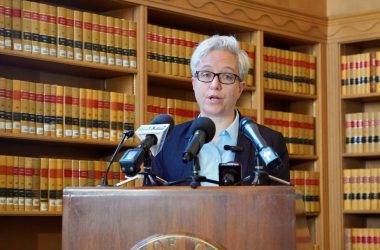Oregonians who packed a legislative hearing on the state’s addiction crisis and flooded the Legislature with passionate testimony have vastly different viewpoints, but on one thing they agree: The status quo is not working.
Some want to repeal Measure 110, the state’s voter-approved drug decriminalization law. Others say it needs to be tweaked. And it’s up to lawmakers to find solutions to Oregon addiction crisis that has killed scores of people and affected most people’s lives.
They’re on a tight deadline, too, with next year’s short session looming as deep-pocketed business leaders push for a ballot measure to recriminalize drug possession and mandate treatment if lawmakers don’t act in the next few months.
There’s no easy solution to the multifaceted issue of drug addiction, experts told lawmakers during a four-hour meeting on Monday. Solving one of the state’s most pressing issues will take more treatment, more housing and concerted efforts from health care providers, counselors, other people in recovery and law enforcement, they said.
Some discussed the benefits of addiction medications, while others stressed the role of peers, or trained people in recovery, guiding patients toward health. Lawmakers also listened to police officers who oversee treatment programs in jail and heard from elected officials, including Portland Mayor Ted Wheeler, who called on lawmakers to ban the public use of drugs.
There were personal tales, too, like that of Morgan Godvin, commissioner of the Oregon Alcohol and Drug Policy Commission. She buried her first friend from an opioid addiction in 2011 and then landed in prison before clawing her way out of addiction.
One of the most impassioned pleas came from Lisa Schroeder, chef and owner of Mother’s Bistro & Bar in Portland, who said business owners, staff, the public and police face a roving downtown drug market that emerges on one corner, disappears, then pops up on another.
“We’ve been victims of vandalism and other property crimes over the years, but nothing like I have seen since the passage of Measure 110,” Schroeder said. “The drugs make people brazen, committing crimes they’d never committed before.”
“I’m therefore begging the Legislature to reform, change or revise Measure 110 so there are consequences for public use and possession of more than a small amount of drugs,” Schroeder added.
Nearly two dozen people spoke at Monday’s meeting, the third held by the Joint Interim Committee on Addiction and Community Safety Response. About 300 others have submitted written public testimony, with new comments streaming in daily.
The five Democrats and three Republicans on the committee will meet again in January, giving them little time to develop solutions to Oregon’s addiction and public safety crisis for the legislative session, which begins Feb. 5.
Addiction has killed hundreds of people in Oregon, and the death toll is only getting worse. The Centers for Disease Control and Prevention says more than 1,500 people have likely overdosed in Oregon in the past year, marking a nearly 30% increase over the year before. That’s the nation’s second highest rate after Washington state, where nearly 40% more people overdosed in the past year compared with the year before.
The crisis is heavily affecting Black people and Native Americans. Dr. Todd Korthuis, addiction medicine chief at Oregon Health & Science University, said the overdose rates of those communities is double that of white people. The toll among young people is also high.
“Oregon has the fastest-growing youth drug death rate in the U.S.,” Korthuis said.
At the heart of the crisis is fentanyl, which is cheap and plentiful. It is 50 times more potent than heroin and short acting, requiring people to take it every hour or two to stave off withdrawal symptoms. It also builds up in the body and stays in tissues.
“All of this leads to a much more addictive opioid than we’ve seen before, and that results in longer and more intense withdrawal symptoms and makes it more difficult to stay in recovery,” Korthuis said.
Roads to recovery
Providers have two key medications for treating opioid addiction – methadone and buprenorphine. The former is considered the gold standard, but it’s tied in federal regulations. The latter is more easily prescribed. There are not enough providers, and people need to stay on the medications, sometimes for life. But they work, experts said.
“Addiction is a treatable brain disease,” said Dr. Moxie Loeffler, a Eugene addiction specialist and past president of the Oregon Society of Addiction Medicine. “We often think of it as a social problem or moral issue, but treatment is just as effective for addiction as for other chronic conditions like diabetes and heart disease.”
The state lacks clinics, though telemedicine can help, said Dr. Brian Dawson, chief medical officer of Ideal Option, a large provider with nine clinics in the state. He said telemedicine is a good option for treating people in rural and remote areas, though it has drawbacks.
“Sometimes it’s difficult to figure out how you’re going to continually monitor patients and do effective drug testing on patients who aren’t coming into a physical clinic,” Dawson said.
The first step is to get people into treatment. When patients are ready, they need quick access to a provider. Waiting even a day might mean they change their mind.
“One of the problems that we face in addiction is the danger of delayed care,” Loeffler said. “What that means is that if you want to make a health behavior change, it’s best if someone doesn’t put you on a wait-list.”
Having so-called peers who’ve struggled with drug addiction guide others toward recovery is crucial, specialists said. Korthuis called them the “secret sauce” between using drugs and treatment.
A rural Oregon initiative enlisted peers to befriend people on drugs who weren’t looking for treatment. They helped enroll more than 600 drug users. After three months, nearly 80% accepted peer and harm reduction services, which are designed to keep people alive, and nearly 15% engaged in treatment.
The Oregon Health Authority has a program focused on peers called Prime Plus. It currently includes at least 50 peers in 20 counties, according to its website. Next year, the agency plans to expand those services to all of the state’s 36 counties to prevent overdoses and intervene in cases involving methamphetamine, which often causes schizophrenia-like psychotic symptoms and is linked to aggressive and violent behavior.
Role for law enforcement
Many drug users end up behind bars – not for consumption or possession under Oregon law but for crime. Korthuis urged lawmakers to include law enforcement in addressing the drug crisis.
“Clearly, treatment is going to be more effective than incarcerating anyone,” Korthuis said. “However, I do believe that there’s a role for law enforcement in their communities that, specifically in the context of diversion programs, can achieve success.”
Opinions are sharply divided on the role police officers should play, with some, including a group behind a ballot measure that would tighten Measure 110, urging criminal penalties for personal possession along with mandated treatment. Korthuis threw support behind that.
“We know that mandatory treatment for health care providers and airline pilots actually achieve the highest quit rates and job retention rates in the industry,” Korthuis said. “There are also programs like the 24/7 sobriety program that actually have been well-studied and decrease the risk of death in people with repeat drunk driving by 50%.”
He said drug courts reduce drug use by about 12%, but that figure would be higher if the state had stronger links between incarceration and community-based care.
Lincoln County is one of several that provide addiction treatment for people behind bars. Medicaid won’t foot the bill, so jails have to rely on state grants, their budget, partnerships with external entities and opioid settlement money, said Lt. Jamie Russell, jail commander in Lincoln County.
Programs need to be multifaceted to work, she said.
“Successful (medication) programs require a multi-layer approach,” Russell said. “Medication is only one piece of the equation. Effective treatment, monitoring and counseling are important components as well.”
She said jails need to establish relations with community providers to help people stay on treatment once they’re released, achieve stability and refrain from crime.
Protecting the community is at the heart of a program involving law enforcement nationwide. Called LEAD, or Law Enforcement Assisted Diversion, it involves police officers and others who refer people on drugs who’ve committed crimes or who are likely to do so to a program of treatment and support. The program is in 85 jurisdictions nationwide, including Multnomah and Marion counties, said Brendan Cox, former police chief in Albany, New York, and the director of policing strategies for the LEAD National Support Bureau.
“The LEAD model was built in response to that inescapable fact that people don’t recover or stabilize immediately,” Cox said. “We need a long-term care coordination framework that acknowledges that. And people may still be out there doing problematic things while we’re working with them, and we need to continue to work with them while those things are happening.”
The program directs people to a case management system and involves coordination among case managers, police, prosecutors and community members who track the person’s progress. Those who stay in the program might have their criminal cases dismissed, depending on the situation. People who testified about the program said the criminal justice system will not solve the drug crisis.
“Expensive punishment and coercion is not an appropriate response to behavioral health issues and poverty,” said Malika Lamont, who works with the LEAD program in Seattle. “People need support, not punishment.”
Getting people to stay in recovery will require much more than expanded treatment, several said. Drug users in poverty will never maintain recovery unless they have housing and a source of income. They need stability in their lives.
“If you just eliminate drugs, you have not addressed the driving circumstances that led to that and other injuries and problematic behavior and circumstances,” said Lisa Daugaard, co-executive director of the Seattle-based social services group Purpose Dignity Action. “That means tackling very fragmented, partial and stubborn systems that are not built to work for our folks.”
She added: “They need a champion and they may need that person for some time.”
Oregon Capital Chronicle is part of States Newsroom, a network of news bureaus supported by grants and a coalition of donors as a 501c(3) public charity. Oregon Capital Chronicle maintains editorial independence. Contact [email protected]. Follow Oregon Capital Chronicle on Facebook and Twitter.




